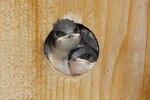
Seeing a toucan leaves you amazed; it's that beak. For example, the toco toucan (Ramphastos toco), the largest toucan, has a 25-inch long body. The toco's beak measures an additional 7.5 inches. Researchers first thought the toucan's beak was only important for attracting mates, but new research indicates the construction of the beak enables the toucan to fly and to reach food and maintain body temperature.
Darwin's Finches

Bird beaks come in many shapes and sizes. Charles Darwin was among the first to think about the "why" of beak formation while looking at finches on the Galapagos islands. Darwin concluded, and further research supported, beak evolution was dependent upon the food sources birds encountered. Accessing certain foods requires a specific type of beak. Cardinals have beaks for eating seed. Hummingbirds beaks collect nectar. Toucan beaks reach fruit.
Toucan Beak
Bird beaks are made of keratin, just like human hair and nails. There are two beak parts: an upper and lower mandible. The upper mandible attaches to the skull and is stationary. The lower mandible is hinged. A toucan lives in the rain forest canopy and needs to reach fruit at the end of flimsy branches. The beak is used like a set of tongs, or chopsticks. The bird can sit on a secure limb, reach, pluck then toss the fruit to the back of its mouth.
Natural Temperature Control
In 2009, Canadian researcher Glenn Tattersall thought the bill of a toucan represented "a significant surface area for heat exchange." To test the hypothesis, Tattersall used infrared thermography. Developed for the U.S. military, thermography means a picture of temperature. Using the technology to examine a toco toucan beak, researchers discovered the beak helped the toucan regulate its body temperature. An overheated toucan releases heat through its bill. When temperatures drop, the toucan constricts blood vessels in the beak to conserve energy and stay warm.
Beaks Teach Engineers
Brazilian born researcher Mark Meyers brought his fascination with the toucan beak to engineering. Computer modeling of a toco toucan beak revealed the beak was strong, but light. “It's almost as if the toucan has a deep knowledge of mechanical engineering," Meyers said. The composition of the beak consisted of "bony fibers and drum-like membranes sandwiched between outer layers of keratin." The toucan beak is about 1/20th of the birds overall weight, allowing for flight.
References
- The Independent: Mystery of the Toucan's Beak Solved
- Project Beak: Adaptations
- Harvard Gazette: How Darwin's finches got their beaks
- Toucans, Woodpeckers and Their Relatives
- Environmental Physiology Lab: Research Projects: Bird Bills as Thermoregulatory Organs
- Wired: Toucan Beak Is New Kind of ‘Heating Bill’
- USCD Jacobs School of Engineering: Engineers Discover Why Toucan Beaks Are Models of Lightweight Strength
- Ask Nature: Beak design absorbs high-energy impacts: toco toucan
Resources
Photo Credits
-
John Foxx/Stockbyte/Getty Images




